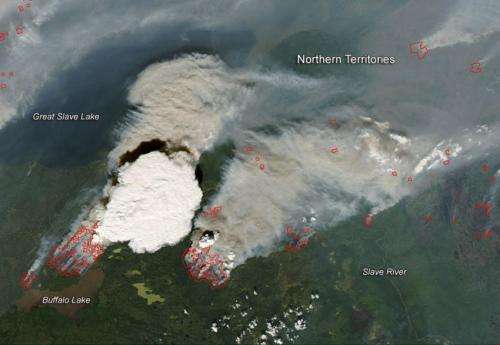Pyrocumulonibus cloud rises up from Canadian wildfires

The Northern Territories in Canada is experiencing one of its worst fire seasons in history. As of this date, there have been 344 wildfires that have burned 2,830,907 hectares of land (close to 7 million acres). The area around the Great Slave Lake, Yellowknife, Ft. Smith, and the Buffalo Lake have been plagued with uncontrolled fires all season long. This natural-color image collected by the Moderate Resolution Imaging Spectroradiometer (MODIS) aboard the Aqua satellite on August 05, 2014 shows a pyrocumulonimbus cloud erupting from the fire north of Buffalo Lake. It is a rare sight to see on satellite imagery. While fire clouds occur with some regularity, it's rare for Aqua to capture images of such mature pyrocumulus clouds. Because of their orbits, Terra always crosses the equator in the morning and Aqua always crosses in the early afternoon (local time). Since pyrocumulus clouds are most developed in the late afternoon or evening, they tend to look small and immature in MODIS imagery.
Pyrocumulonimbus clouds are an extreme manifestation of the pyrocumulus clouds —sometimes called "fire clouds"— which are tall, cauliflower-shaped, and appear as opaque bright white clouds hovering over darker smoke in satellite imagery. Pyrocumulus clouds are similar to cumulus clouds, but the heat that forces the air to rise (which leads to cooling and condensation of water vapor) comes from fire instead of sun-warmed ground. Under certain circumstances such as this one, pyrocumulus clouds can produce full-fledged thunderstorms,turning them into the pyrocumulonimbus clouds present in this image.
Scientists monitor pyrocumulonimbus clouds closely because they can inject smoke and pollutants high into the atmosphere. As pollutants are dispersed by wind, they can affect air quality over a broad area affecting areas far from the fire site. Currently large portions of the Northwest Territories are under a health alert due to the smoke resulting from these wildfires. The smoke released by any type of fire (forest, brush, crop, structure, tires, waste or wood burning) is a mixture of particles and chemicals produced by incomplete burning of carbon-containing materials. All smoke contains carbon monoxide, carbon dioxide and particulate matter (PM or soot). Smoke can contain many different chemicals, including aldehydes, acid gases, sulfur dioxide, nitrogen oxides, polycyclic aromatic hydrocarbons (PAHs), benzene, toluene, styrene, metals and dioxins. The type and amount of particles and chemicals in smoke varies depending on what is burning, how much oxygen is available, and the burn temperature.
Exposure to high levels of smoke should be avoided. Individuals are advised to limit their physical exertion if exposure to high levels of smoke cannot be avoided. Individuals with cardiovascular or respiratory conditions (e.g., asthma), fetuses, infants, young children, and the elderly may be more vulnerable to the health effects of smoke exposure.
Provided by NASA's Goddard Space Flight Center




















